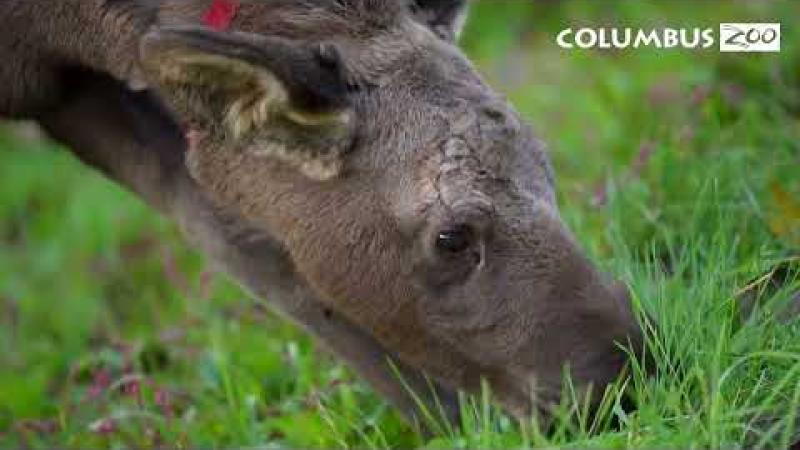As Alaskan moose Bert, Scarlet and Violet explore and settle into their new habitat in the North America region, we wanted to share with you the sentimental meanings behind their names and also highlight the partnerships the Columbus Zoo and Aquarium has with many organizations and zoo across the country to provide second chances to animals who are displaced by natural disasters, like wildfires, orphaned, rescued or rehabbed due to injuries.
What’s in a Name?
The calves’ early life was fraught with uncertainty; however, our colleagues at the Alaska Department of Fish and Game, who found all three calves, and the Alaska Zoo, provided the calves an opportunity to thrive. The teams estimate the calves are about five months old.
Bert, who is the largest of the calves weighing 348 pounds, was found running along the beach near Nikiski, Alaska. Staff from the Alaska Department of Fish and Game suspect he fell off the bluff, becoming separated from his mother. After a thorough search, his mother was not located. He was brought to the Alaska Zoo in May of 2022.

A heartfelt donor Pam Bertram chose the name “Bert” as a tribute to her father, Ansel Bertram. Originally from Kentucky, Ansel and his wife Joan moved to Newark, Ohio in 1955. He and Joan raised their two daughters, Pam and Bridgitt with a very modest upbringing, worked in construction and eventually established his own successful construction company. Pam and her husband Dave Laing have resided in Montana for 2 years. She first visited Montana on a family trip as a child and has vacationed there for the last 20 years. Saying “yes” to this incredible naming opportunity means the world to Pam to recognize her dad’s inspiration, and her love of moose and wildlife.
The North America team decided to pay homage to the two female calves by naming them after Alaskan plants.
“Similar to Strawberry (Alaskan Moose) who was found on Strawberry Road, the names, Scarlet and Violet, were chosen to keep connections to their birthplace in Alaska. Scarlet paintbrush and stream violet are native plants in Alaska,” said North America Keeper, Brian Hollingsworth.
Sadly, Violet’s mother rejected her for unknown reasons. When the Alaska Department of Fish and Game brought her to the Alaska Zoo she was thin and dehydrated. With the love and care of the team at Alaska Zoo, she flourished and is now at a healthy weight of more than 240 pounds.
Unfortunately, neither the team at Alaska Zoo, nor Alaska Department of Fish and Game know the circumstances contributing to Scarlet’s story. She weighs 245 pounds.
Watch the video below to learn more about the moose calves are settling in at the Columbus Zoo.
Lifesaving Partnerships
The North America region at the Columbus Zoo is unique in that an estimated 70 percent of the animals were either displaced by natural disasters, like a wildfire, orphaned, rescued or rehabbed due to injuries. The partnership that the Columbus Zoo and Aquarium have with organizations like the Alaska Zoo and the Alaska Department of Fish and Game is vital to provide a safe place for these animals to have a second chance. It’s also an opportunity for guests to learn about the effects of climate change, human-wildlife coexistence, and much more.
In 2020, one small male cougar kitten made national and international headlines when he was found by California Department of Wildlife severely burned and injured due to the ravaging California wildfires. Captain Cal, as he was later named, was taken to the Oakland Zoo for rehabilitation.
After months of surgeries, rehab, Captain Cal, along with Goldie and Poppy made the trip from the West Coast to the Midwest.
The Columbus Zoo worked with Oakland Zoo to bring three mountain lion cubs to Central Ohio thanks to FedEx generously donating the transport.
There are similar stories for other notable animals such as brown bears, Buckeye and Brutus, black bears, Joanie and Stevie, Alaskan moose Strawberry, three bald eagles, and much more.
“The relationships that we have forged at our partner zoos have proven invaluable. Frequently, these placements need to occur quickly as most State Fish and Game bureaus do not have the personnel or space needed to house orphaned or injured wildlife. Our partner zoos give these animals the time and space they need to be ready to move to a forever home while we get our paperwork in order. Without them, our efforts would be thwarted before they could even get off of the ground,” said North America Curator Nikki Smith.
These partnerships happen with several other species across the Zoo including manatees, sea turtles, an otter, pelicans and an array other birds etc.
The Columbus Zoo and Aquarium is part of the Manatee Rescue & Rehabilitation Partnership (MRP), a cooperative group of entities dedicated to the rescue, rehabilitation, release, and monitoring of manatees.
“The need to protect our native wildlife is extensive. Pooling our expertise and sharing resources allows us to have the biggest impact,” said VP of Animal Care, Doug Warmolts
Smith, who has been on numerous trips to pick up orphaned animals, agrees.
“We have also built friendships with keepers and managers at zoos across the country and we frequently share photos, updates, and follow up information. There’s a network of organizations and individuals who make a difference. Our partners at the airlines, like FedEx, and DHL Express have donated airfare and are critical to getting these animals to us here in Columbus. It’s an ‘all hands on deck’ approach,” said Smith.










